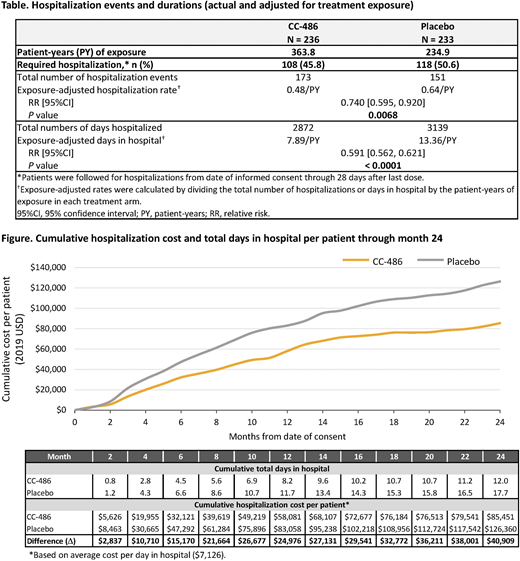BACKGROUND: AML is an aggressive malignancy primarily affecting older individuals. Although 40%-60% of patients (pts) aged >60 years attain complete remission (CR) with IC, 80%-90% of them eventually relapse. In the continuum of AML care, the greatest expenditures are associated with relapsed/refractory disease, and hospitalization is the largest component (~70%) of direct AML healthcare costs (Pandya, 2020).
In the randomized, phase III QUAZAR AML-001 Maintenance Trial, CC-486, an oral hypomethylating agent, significantly prolonged overall (OS) and relapse-free survival (RFS) vs. placebo (PBO) in pts with newly diagnosed (ND) AML in first remission following IC.
OBJECTIVE: Determine rates of hospitalization and days in hospital with CC-486 and PBO in QUAZAR AML-001, and quantify associated costs of hospitalization using unit costs estimated from a US claims database.
METHODS: In QUAZAR AML-001, eligible pts were age ≥55 years, with de novo or secondary AML, intermediate- or poor-risk cytogenetics, and ECOG PS ≤3; achieved first CR or CR with incomplete count recovery (CRi) after IC ± consolidation; and were not candidates for hematopoietic stem cell transplant (HSCT). Within 4 months of CR/CRi, pts were randomized 1:1 to CC-486 300 mg or PBO, administered once-daily on days 1-14 of repeated 28-day cycles. Pts who received ≥1 dose of study drug were followed for hospitalizations and durations of stay from date of informed consent through 28 days after last dose. The mean number of days hospitalized per month (30 days) in each treatment arm was computed by dividing the aggregate number of hospitalized days by the number of ongoing pts at each time-point. Rates of hospitalization and days in hospital were also adjusted for duration of CC-486 and PBO exposure. 95% confidence intervals (CI) for relative risk (RR) estimates and associated P values are based on asymptotic methods.
Patients with a primary diagnosis of AML, preceded by ≥6 months (baseline) without a claim for AML were identified in the IBM MarketScan Commercial & Medicare database from April 2013 to July 2019. A stepwise procedure was then used to include pts aged ≥55 years at diagnosis, without a diagnosis of another primary cancer or HSCT, and with insurance coverage during the entire 6-month baseline period. Unit cost of hospitalization was derived as the average total AML-related hospitalization costs incurred per day of stay, adjusted for inflation to 2019 US dollars.
RESULTS: In all, 469 pts were enrolled in QUAZAR AML-001 and received CC-486 (N=236) or PBO (N=233). Total exposure to CC-486 was 363.8 pt-years (PY) and to PBO was 234.9 PY.
In all, 108 pts (45.8%) in the CC-486 arm and 118 (50.6%) in the PBO arm were hospitalized. The total numbers of hospitalizations were 173 in the CC-486 arm and 151 in the PBO arm; however, the exposure-adjusted rate of hospitalization was significantly lower in the CC-486 arm: 0.48/PY vs. 0.64/PY, respectively (RR 0.740 [95%CI 0.595, 0.920]; P = 0.0068) (Table). The total number of days hospitalized was 2872 in the CC-486 arm and 3139 in the PBO arm, and the exposure-adjusted days-in-hospital rate was significantly lower in the CC-486 arm (7.89/PY vs. 13.36/PY in the PBO arm; RR 0.591 [95%CI 0.562, 0.621]; P < 0.0001) (Table).
Of the ND-AML cohort identified in the MarketScan database, 3058 pts had ≥ 1 noncapitated hospitalization and provided the basis for estimated hospitalization-related costs. Median age and sex distribution of these pts were generally consistent with those of pts in QUAZAR AML-001. The mean AML-related hospitalization cost incurred in the database was $7,126/day (2019 USD). Thus, based on exposure-adjusted days-in-hospital rates in the CC-486 and PBO arms (7.89/PY and 13.36/PY, respectively), the estimated mean costs of hospitalization in QUAZAR AML-001 were $56,224/PY in the CC-486 arm and $95,201/PY in the PBO arm. Cumulative cost savings in the CC-486 arm compared with PBO ranged from $2,837 in month 2 to $40,909 by month 24 (Figure).
CONCLUSION: CC-486 was associated with significantly reduced exposure-adjusted risk of hospitalization and days in hospital compared with PBO, which are estimated to result in substantial cumulative cost savings. Significantly prolonged RFS with CC-486 vs. PBO in this study (10.2 vs. 4.8 months; P = 0.0001) may translate into substantial economic benefits, with lower hospitalization-related costs due to reduced rates of hospitalization and days in hospital.
Oliva:Alexion: Consultancy; Apellis: Consultancy; Abbvie: Consultancy; Amgen: Consultancy; Novartis: Consultancy; BMS: Consultancy, Honoraria, Patents & Royalties, Speakers Bureau. Oriol:Amgen: Consultancy, Speakers Bureau; Janssen: Consultancy; Sanofi: Membership on an entity's Board of Directors or advisory committees; GlaxoSmithKline: Membership on an entity's Board of Directors or advisory committees; Bristol-Myers Squibb: Membership on an entity's Board of Directors or advisory committees, Speakers Bureau. La Torre:Bristol Myers Squibb: Current Employment, Current equity holder in publicly-traded company. Skikne:Bristol Myers Squibb: Current Employment. Beach:Bristol Myers Squibb: Current Employment, Current equity holder in publicly-traded company. Kumar:Bristol Myers Squibb: Current Employment, Current equity holder in publicly-traded company. Dong:Bristol Myers Squibb: Current Employment, Current equity holder in publicly-traded company. Chen:Bristol Myers Squibb: Current Employment, Current equity holder in publicly-traded company. Ranjan:SmartAnalyst India Pvt. Ltd.: Current Employment. Kiendrebeogo:SmartAnalyst, Inc.: Current Employment. Braun:Servier: Research Funding; Daiichy-Sankyo: Honoraria.
Author notes
Asterisk with author names denotes non-ASH members.


